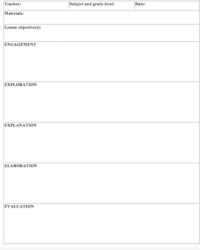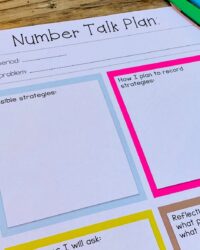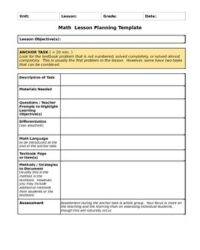The integration of mathematics into Career and Technical Education (CTE) isn’t just a trend; it’s a fundamental shift towards preparing students for the real-world demands of their chosen fields. Often, the math concepts students learn in traditional classrooms feel abstract, disconnected from their future careers. However, within a CTE setting, these very concepts come alive, providing a practical context that makes learning more meaningful and applicable. The challenge for educators lies in effectively bridging this gap, ensuring that mathematical understanding is not just taught, but truly embedded within the hands-on CTE curriculum.
This is where a well-structured framework becomes invaluable. Imagine having a clear, concise guide that helps you identify the inherent mathematical connections in every CTE skill, allowing you to seamlessly weave them into your lessons. That’s precisely the power of a dedicated math in CTE lesson plan template. It provides a roadmap, ensuring consistency, clarity, and most importantly, effective learning experiences that prepare students not just for exams, but for successful careers.
The Core Components of an Effective Math in CTE Lesson Plan
Crafting a lesson that seamlessly blends CTE skills with mathematical principles requires more than just a passing thought; it demands thoughtful planning and a structured approach. An effective math in CTE lesson plan template serves as your blueprint, ensuring that every element contributes to a comprehensive learning experience. It helps you articulate how a student will not only master a technical skill but also understand the underlying mathematical concepts that make that skill possible and efficient in a real-world context.
At its heart, such a template focuses on dual learning objectives: what CTE skill will be taught, and what mathematical concept will be reinforced or introduced within that context. For instance, in a culinary arts class, students might learn to scale a recipe (CTE skill) while simultaneously applying ratios and proportions (math concept). The template prompts you to consider the specific industry standards for the CTE area and the corresponding state or national math standards. This dual alignment ensures that your lesson is rigorous both technically and academically, meeting the expectations of various curricula.
Beyond objectives, the template guides you through the instructional procedures. How will you introduce the CTE skill? When and how will the mathematical concept be explicitly taught or reviewed within that practical application? This section often includes step-by-step instructions for activities, problem-solving scenarios, and guided practice that highlight the math-in-action. Think about the materials and resources needed, ensuring they support both the CTE task and the mathematical exploration, whether it’s measuring tools, blueprints, spreadsheets, or specific software.
Finally, an effective template compels you to consider assessment and differentiation. How will you know if students have grasped both the CTE skill and the mathematical concept? This might involve performance-based assessments where students apply math in a practical CTE task, or traditional problem-solving exercises related to the CTE context. Furthermore, how will you support students who need extra help or challenge those who are ready for more? The template acts as a reminder to build in strategies for diverse learners, ensuring equitable access to complex concepts.
Key Elements to Include
- CTE Standards Alignment
- Math Standards Alignment
- Dual Learning Objectives (for CTE and Math)
- Required Materials and Resources
- Step-by-Step Instructional Procedures
- Embedded Math Activities/Problems
- Assessment Methods (Formative and Summative)
- Differentiation Strategies
Why a Template is Crucial
Using a standardized math in CTE lesson plan template isn’t just about ticking boxes; it’s about fostering consistency and efficiency. It ensures that every lesson comprehensively covers all necessary components, from clear objectives to practical application and assessment. This consistency benefits not only the teachers, who save time and ensure thoroughness, but also the students, who experience a more cohesive and logical learning progression. It’s a tool for continuous improvement, allowing educators to refine their approach lesson after lesson.
Implementing Your Math in CTE Lesson Plan Template
Once you have a robust math in cte lesson plan template, the next step is putting it into action in your classroom or workshop. This isn’t just about filling in blanks; it’s about actively thinking through the specific CTE task and identifying the natural mathematical connections that already exist. For instance, if you’re teaching automotive technology, consider the math involved in calculating engine displacement, gear ratios, or tire pressure. In healthcare, think about dosage calculations, understanding vital sign trends, or interpreting lab results. The template guides you to make these connections explicit, rather than leaving them as implied background knowledge.
Successful implementation often thrives on collaboration. Imagine CTE instructors working hand-in-hand with math teachers to refine lessons. The CTE expert can pinpoint the practical scenarios where math is essential, while the math expert can help identify the precise mathematical concepts and language to use. This cross-disciplinary teamwork enriches the lesson plan, making it more robust and relevant for students. Furthermore, the template can be adapted across various CTE pathways—whether it’s construction, information technology, agriculture, or hospitality—ensuring its versatility and broad applicability.
Remember that a lesson plan, even with a great template, is a living document. After you’ve taught the lesson, take time to reflect. Did students grasp the math concepts within the CTE context? Were the activities engaging? Did the assessment accurately measure understanding? Use student feedback and your own observations to revise and refine your template and the specific lesson. This iterative process of planning, implementing, and reflecting is key to continuous improvement and ensuring that every lesson effectively bridges the gap between theoretical math and practical CTE skills.
- Start by identifying the primary CTE skill to be taught in the lesson.
- Brainstorm all the mathematical concepts inherently involved in that CTE skill.
- Select specific math concepts that are appropriate for the students’ current level and relevant to the CTE task.
- Design activities or problems that require students to apply these mathematical concepts within the CTE context.
- Plan how to explicitly teach or review the mathematical principles alongside the CTE procedures.
- Develop clear criteria for assessing both the CTE skill proficiency and the mathematical understanding.
- Review and adjust the lesson plan based on student performance and engagement.
Embracing a structured approach to integrating mathematics into CTE is a powerful way to enhance student learning. By making the implicit mathematical foundations of various careers explicit, we empower students with a deeper understanding and a more robust skill set. This integration not only boosts their academic proficiency but also sharpens their critical thinking and problem-solving abilities, which are invaluable in any professional field.
Ultimately, providing students with this holistic educational experience prepares them not just for entry-level positions, but for lifelong learning and adaptability in an ever-evolving workforce. When math is seen not as an isolated subject, but as an integral tool for success in their chosen career path, students become more engaged, more motivated, and better equipped to tackle the challenges of their future professions.


